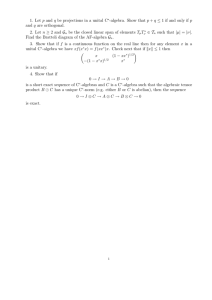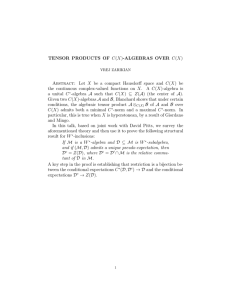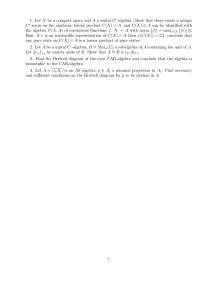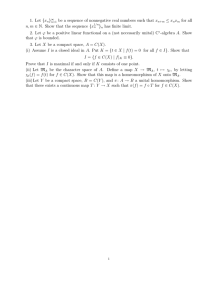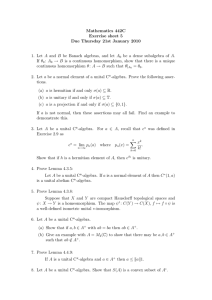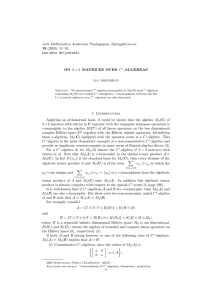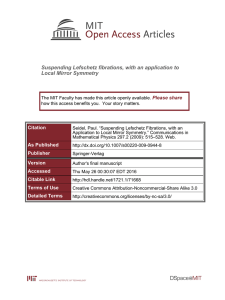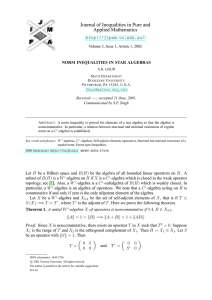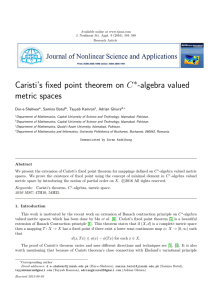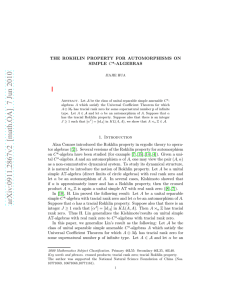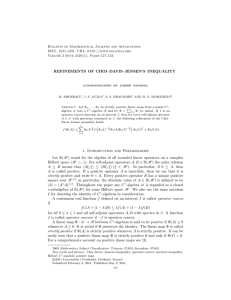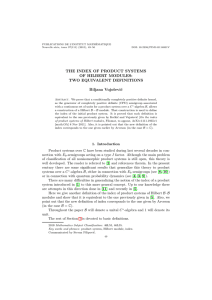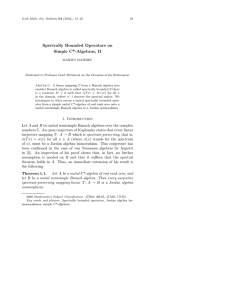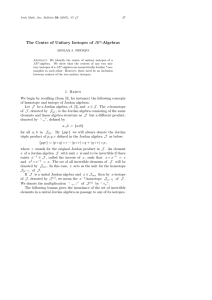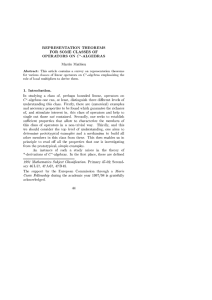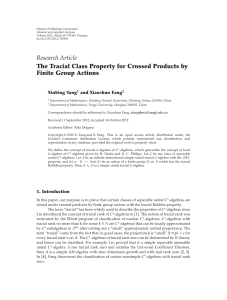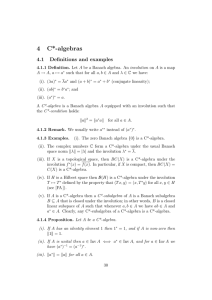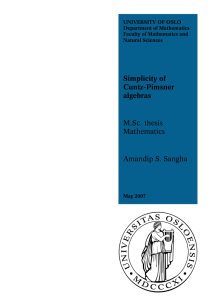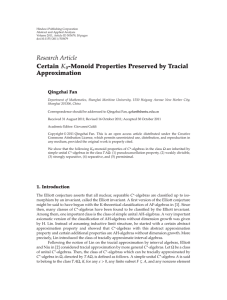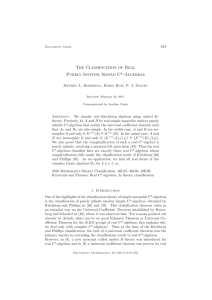MATH 656 - Spring 2016 Homework Assignment 3
advertisement
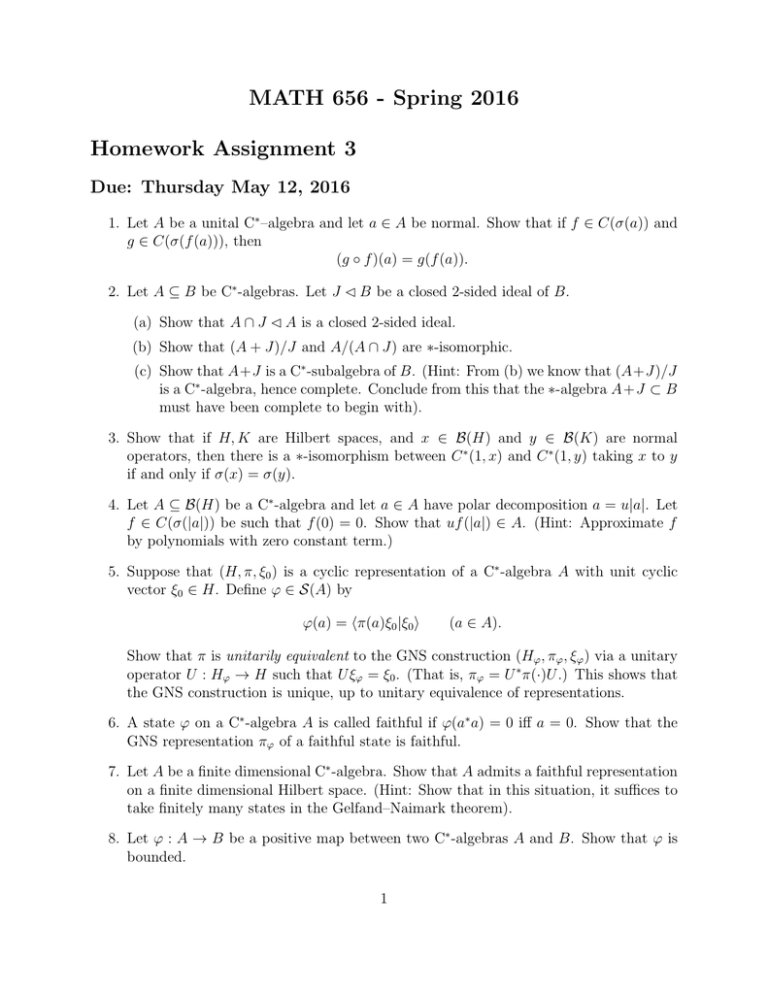
MATH 656 - Spring 2016 Homework Assignment 3 Due: Thursday May 12, 2016 1. Let A be a unital C∗ –algebra and let a ∈ A be normal. Show that if f ∈ C(σ(a)) and g ∈ C(σ(f (a))), then (g ◦ f )(a) = g(f (a)). 2. Let A ⊆ B be C∗ -algebras. Let J C B be a closed 2-sided ideal of B. (a) Show that A ∩ J C A is a closed 2-sided ideal. (b) Show that (A + J)/J and A/(A ∩ J) are ∗-isomorphic. (c) Show that A+J is a C∗ -subalgebra of B. (Hint: From (b) we know that (A+J)/J is a C∗ -algebra, hence complete. Conclude from this that the ∗-algebra A+J ⊂ B must have been complete to begin with). 3. Show that if H, K are Hilbert spaces, and x ∈ B(H) and y ∈ B(K) are normal operators, then there is a ∗-isomorphism between C ∗ (1, x) and C ∗ (1, y) taking x to y if and only if σ(x) = σ(y). 4. Let A ⊆ B(H) be a C∗ -algebra and let a ∈ A have polar decomposition a = u|a|. Let f ∈ C(σ(|a|)) be such that f (0) = 0. Show that uf (|a|) ∈ A. (Hint: Approximate f by polynomials with zero constant term.) 5. Suppose that (H, π, ξ0 ) is a cyclic representation of a C∗ -algebra A with unit cyclic vector ξ0 ∈ H. Define ϕ ∈ S(A) by ϕ(a) = hπ(a)ξ0 |ξ0 i (a ∈ A). Show that π is unitarily equivalent to the GNS construction (Hϕ , πϕ , ξϕ ) via a unitary operator U : Hϕ → H such that U ξϕ = ξ0 . (That is, πϕ = U ∗ π(·)U .) This shows that the GNS construction is unique, up to unitary equivalence of representations. 6. A state ϕ on a C∗ -algebra A is called faithful if ϕ(a∗ a) = 0 iff a = 0. Show that the GNS representation πϕ of a faithful state is faithful. 7. Let A be a finite dimensional C∗ -algebra. Show that A admits a faithful representation on a finite dimensional Hilbert space. (Hint: Show that in this situation, it suffices to take finitely many states in the Gelfand–Naimark theorem). 8. Let ϕ : A → B be a positive map between two C∗ -algebras A and B. Show that ϕ is bounded. 1 9. Let A, B be unital C∗ -algebras and ϕ : A → B a 2-positive map. (a) Prove the Schwarz inequality for ϕ: kϕ(b∗ a)k ≤ kϕ(b∗ b)k1/2 kϕ(a∗ a)k1/2 (a, b ∈ A) (b) Use the above to conclude that kϕ(a)k2 ≤ kϕ(1)kkϕ(a∗ a)k (a ∈ A). (c) Use the above to conclude that kϕk = kϕ(1)k. (Note: This is not always true if ϕ is merely positive.) Hint: For (a), you may use the following lemma (applied to a suitable choice of X). Lemma 0.1. Let A ⊂ B(H) be a unital C∗ -algebra and let x y X= ∈ M2 (A). z w Then X ∈ M2 (A)+ if and only if x, w ≥ 0, y = z ∗ , and |hyξ|ηi|2 ≤ hxξ|ξihwη|ηi for every ξ, η ∈ H. 10. Let t : M2 (C) → M2 (C) denote the transpose map. In class we showed that t is positive. Show that t is not 2-positive. 11. Let H be a separable Hilbert space with ONB (en )n∈N . Show that the map X d : b1 (B(H)) × b1 (B(H)) → [0, ∞); d(x, y) = 2−n−m |h(x − y)en |em i| 1≤n,m<∞ defines a metric on the closed unit ball b1 (B(H)) of B(H). Consequently, the relative weak operator topology on b1 (B(H)) is metrizable. 2
